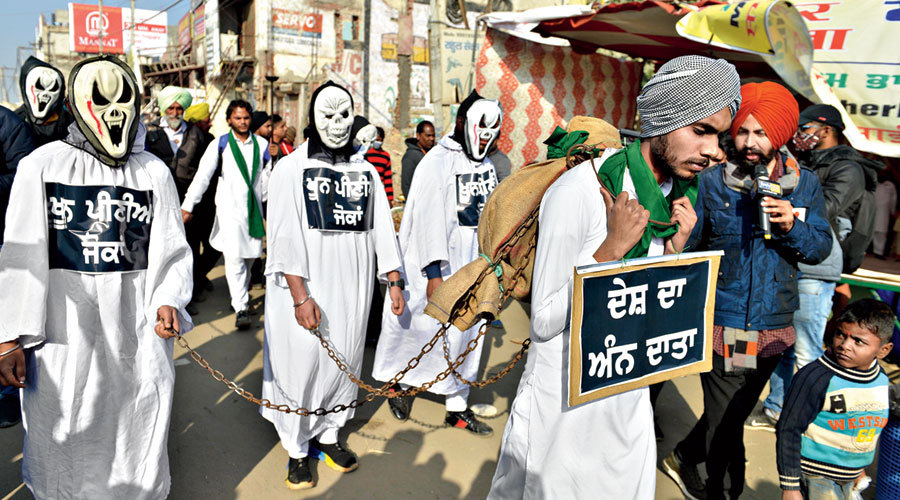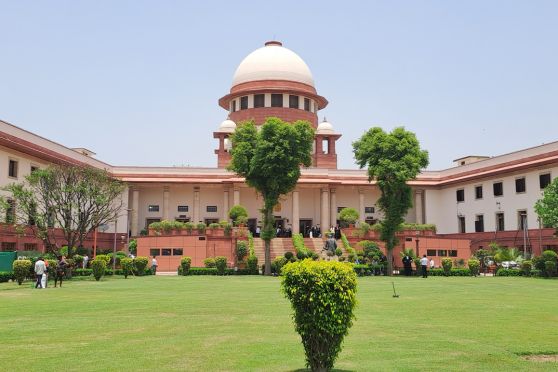The protest site at the Singhu border is a city on a road, extending more than 12km from Dakha Singhu in Delhi through Kundli in Haryana.
In between the long lines of tractor trailers, the agitating farmers and their supporters have set up more than 200 large langars or community kitchens, makeshift bathing and toilet facilities, laundries, stages for events, even gyms.
Devoid of frills, the make-do infrastructure set up on these stretches of highways has become a symbol of the farmers’ resolve and the solidarity they have won.
Amid the bustle, a soldier from Ambala, Haryana, walks around with a bagful of pinnis — Punjabi laddoos made of wheat flour, ghee, jaggery and dry fruits. A pinni with a tumbler of warm milk a day is believed to keep the chill out of one’s body in winter.
“I was coming here with some clothes for a cousin, who is protesting. Several families in our village made pinnis to be given to the protesters here. That is what the Guru (Nanak) has taught us,” the soldier told The Telegraph.
The langars set up at the main protest sites in Singhu, Tikri Kalan and Ghazipur reflect the same fierce self-reliance that prompted the farmer leaders to refuse the food offered by the government during the talks at Vigyan Bhawan.
Many peasants have brought to these community kitchens supplies that will last a few months. The vegetables and milk come from farmers in neighbouring Haryana villages.
Several vendors at the wholesale vegetable market in Bahadurgarh, on the Haryana side of the Tikri border, have been giving the protesters free vegetables.
Mukesh Kumar from Sonipat, Haryana, and his comrades from the Mazdoor Kisan Ekta Zindabad run langars at all the three sites along with medical camps. They have also set up portable toilets.
“It’s hard to calculate the cost. Everyday people walk in and contribute vegetables for us,” Mukesh said.
“People who eat do seva (service): they serve food, wash the dishes, clean the eating area and roll the aata dough into pedas, which we put on the roti machines (that run on a diesel generator).”
Mukesh and his friends serve 2,500-3,000 plates each of lunch and dinner at Singhu. The menu is rice, rotis and two sabzis, with dessert on alternate days.
“The langars are very cooperative. I can walk into any langar and say I have run out of this or that, and they’ll give it to me free. No questions asked,” Mukesh said.
“On the days we don’t make dessert, other langars or individuals come and donate some dessert.”
The group plans to open a fourth langar at the blockade that has begun in Shahjahanpur, Rajasthan, on the Delhi-Jaipur highway.
The vegetarian menus are not bereft of variety. The langar run by Muslim farmers from Malerkotla in Punjab serves zarda or sweetened rice.
On Thursday morning, a man came to distribute macaroni from the back of his car, and by evening a group of young farmers had set up an oven on a road divider to serve pizzas.
In for the long haul despite the falling mercury, the stoves at the langars are unlikely to cool soon.
Khalsa Aid, an international charity, has set up a range of facilities, including bathrooms with hot water, and even a foot massage parlour to soothe the aching feet of the farmers who stand in protest all day. A library and several small gyms too have come up in Singhu. None of these charge any money.
Prince Sandhu, a landlord from Ludhiana, runs one of several free laundry services. “I brought along the washing machine we use at home, and I also bought a new one for more than Rs 12,000,” he said.
“With these two nine-litre machines, I wash almost 500 clothes a day. Those who come wait till the wash finishes and collect their clothes from the dryer. It seems like a big task, but when you do seva you don’t feel the burden.”
Although water supply is a problem locally, Sandhu gets his water through a pipe from a home on the Haryana side of the border.
“The gentleman who lives here has been giving water to a langar too,” he said.
Initially after the protest began on November 27, garbage was piling up faster than the municipal bodies in Delhi and Haryana were able to collect, and the portable toilets had got choked.
After Khalsa Aid and other professionals got involved, and local farmers began helping with garbage disposal, the conditions became more liveable. But a shortage of toilets means they are still becoming unusable soon after being cleaned.
Navkiran Natt, an All India Students Association cadre, attends the protests at all the sites. Her parents, both of them CPIML Liberation activists from Mansa, Punjab, are camping at the Tikri border.
“The public toilets are too few, but many petrol bunks near Singhu allow people to use their toilets free of charge,” Natt said.
“In Tikri (where the protest is smaller), a property dealer near the blockade has opened bathrooms in his office for the women.”
Many travel up to 10km to malls, hotels, the homes of well-wishers, even paid toilets. The situation becomes more challenging for the women protesters during periods. The medical camps here offer free sanitary napkins.
At least 10 protesters are said to have died of heart attacks and one from the cold — the minimum temperatures at some of the protest sites have fallen below 7°C.
Harjit Bhatti, a doctor who volunteers at the sites, said that most of the complaints he received were cold-related.
“Most people come with common cold, body ache and sleep disorders. They are living on a highway, and the older people find it more difficult to cope,” Bhatti, who leads an activist group called Progressive Medicos and Scientists Forum, said.
“People with chronic ailments like diabetes or hypertension too come to us for medicines if they have run out of them, or if their blood pressure or sugar levels
have gone up because they haven’t taken their medicines regularly.”
Although many do not wear masks, or wear them below their nose at the crowded protest sites, Bhatti feels lucky that he has had to refer only one among the 5,000-odd people his team has examined for a Covid-19 test. The patient had difficulty breathing.
“The two cases of fever I have examined in the tractor trailers were weather-related. There is stagnant water here and mosquitoes. When you talk to them about Covid-19, they tell you their livelihood is more important than their lives,” Bhatti said.











